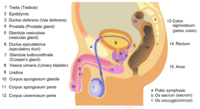
Photo from wikipedia
OBJECTIVES The current study aimed to evaluate the long-term outcomes of TURED (transurethral resection of the ejaculatory duct) in treating male infertility due to ejaculatory duct obstruction (EDO) to the… Click to show full abstract
OBJECTIVES The current study aimed to evaluate the long-term outcomes of TURED (transurethral resection of the ejaculatory duct) in treating male infertility due to ejaculatory duct obstruction (EDO) to the short-term follow-up. METHODS From 2000 to 2010, we retrospectively reviewed 30 men with infertility resulting from EDO who underwent TURED. Information on preoperative evaluation of patients was collected from the medical records. Standardized semen analysis was performed six weeks, three months, and 12-months postoperatively, as well as after a seven-years follow-up. Telephone and mail were used for the long-term follow-up. RESULTS The average age of patients was 35.5±2.6. All patients had low ejaculate volume and normal rang of the mean serum hormone levels (gonadotropins and testosterone). Transrectal ultrasonography (TRUS) assessment, revealed midline cysts in 46.7% (n=14 cases), a seminal vesicle dilatation in 83.3% (25/30 cases) and ED dilatation in 76.7% (23/30 patients). In addition, two patients (6.6 %) underwent magnetic resonance images (MRI) pelvis to confirm equivocal EDO by TRUS. After short-term and long-term follow-up, semen parameters improved significantly in 90% of cases versus 63.3% of cases, respectively, with statistically insignificant differences in all parameters (p ≥ 0. 1). Based on subgroup analysis, semen parameters improved in all partial EDO and cystic EDO cases versus complete EDO and non-cystic EDO, respectively. Spontaneous pregnancies were achieved in 10 (33.3 %) versus 8 (26.6 %) cases after short and long term, respectively. Regarding post-TURED complications, we reported 23.3 % (n=7). CONCLUSION TURED is an effective treatment for ejaculatory duct obstruction. It significantly improves all semen parameters and improves the symptoms related to EDO after short and long-term follow-up.
Journal Title: Journal of endourology
Year Published: 2022
Link to full text (if available)
Share on Social Media: Sign Up to like & get
recommendations!